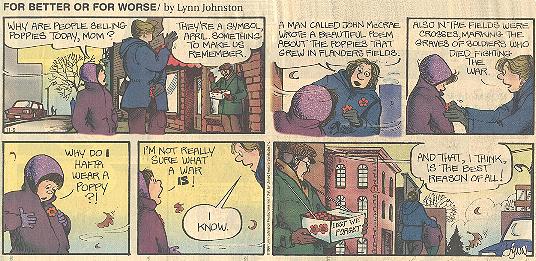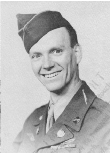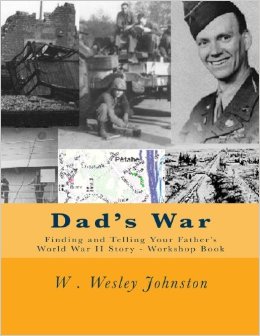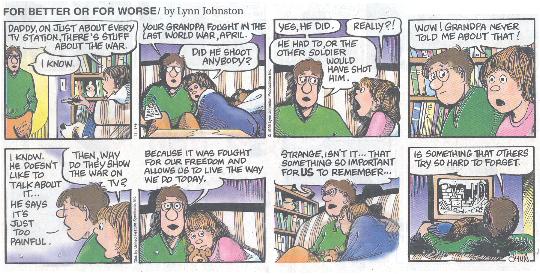First Steps to Finding Your Dad's Story -- Start Here
I have received many requests asking basically the same thing: "How do I find my Dad's story?" Obviously, it is more than a few simple steps (especially for those American GIs -- the majority from both World Wars -- whose personnel files were destroyed in the 1973 fire). But here are the key steps to doing it.
NOTE: This "First Steps" section is aimed at military members in the war. This web page also has information about civilians. So if your father or mother or ... was not in the military or was a member of a special group in or out of the military, jump to here.
Time is the critical factor. Start now to find one of your Dad's buddies before it is too late.

Copyright © 1997 by Lynn Johnston; used with her permission.
Click here for the history of the "Buddy Poppy" and the meaning of November 11.
- Step 1: Positively identify his unit(s), to as low a level as possible.
- If he came home, the best source is his discharge paper. If you do not find it among his papers, then call the VA (phone: (800) 827-1000) if he ever applied for VA benefits. Since they were told that their discharge papers would never be replaced if lost, most men had them legally recorded at the County Recorder's office (the same place that deeds are recorded); so also check the Recorder's office of the county to which he came home. For most men, the unit shown on the discharge was their combat unit. However, for some men who were transferred to other units in order to allow them to come home sooner, the discharge may show the unit with which he came home.
- If he died in the war
- United States
You can find his branch of service, rank, service number, home county and how he died (KIA = Killed in Action, DOW = Died of Wounds, DNB = Died Non-Battle, etc.) -- but NOT his unit -- by searching for him on the World War II Registry of the National World War II Memorial and looking in the resulting link where the Source is designated "National Archives".
- If his body is overseas or was never recovered, obtain his unit, as well as the location of his overseas grave or memorial, from the WWII Registry entries with Source "ABMC Cemeteries" or "ABMC Tablets of the Missing" or by using the World War II Honor Roll of the American Battle Monuments Commission or by calling (703) 696-6897 or writing them at:
American Battle Monuments Commission
Courthouse Plaza II
2300 Clarendon Blvd., Suite 500
Arlington, VA 22201
The AFDIL (Armed Forces DNA Identification Laboratory) Family Outreach Program has been actively collecting mitochondrial DNA from families of MIAs since 1992. Click here to read more about this and find out how to have your family's DNA collected for possible future identification of your MIA family member's remains. Note that each service branch has its own Casualty Office. While the DNA Identification Laboratory web page does have a link to a list of contact information for each branch of service, that list does not include the web sites for those different Casualty Offices. Click here for the Army Human Resources Commands' Past Conflict Repatriation Branch.
-
If he died overseas in the Army, Navy or other service, regardless of whether he was ever found and identified or where he is buried, request his Individual Deceased Personnel File (IDPF) from the U. S. Army Human Resources Command. Here is the address to which you should submit your request through Freedom of Information (FOIA) channels:
U. S. Army Human Resources Command
ATTN: AHRC-PAO (FOIA)
1600 Spearhead Division Avenue
Dept #103
Fort Knox, Ky 40122-5100
|
You can call them at (703) 325-9256, if you have questions, but not to make requests for IDPFs. They require a letter in order to send the IDPF. The letter can also be sent via e-mail to usarmy.knox.hrc.mbx.foia@mail.mil
Your letter to them should include your signed statement of your willingness to pay the Freedom of Information Act fees for the work involved. If you are requesting your relative's IDPF, they will probably not actually charge you. But they cannot do any work to locate the records without this statement from you.
For determining the history of men who died overseas, the IDPF is an extremely valuable record -- the most important record that exists in most cases. The amount of information in the files can vary dramatically. The IDPF will almost always establish his unit and give the information on his burial. In many cases, it will also give valuable information about where and when he died, possibly even including reports of the action in which he died. For men whose remains were never recovered or identified, extremely valuable records of the testimonies of his buddies are usually included, giving extraordinary information about the action, what happened to him, and when they last saw him. Though the information in one IDPF can vary considerably from the information in another and a few of them can contain disappointingly little information, most of them are very useful. There simply is no more valuable record to obtain than the IDPF for most men who died overseas. In some cases, they will not be able to find the record on the first try, and they will suggest that you write back in 6 months. So write again in 6 months, but this time add to the letter that this is your second request, since they were unable to locate the record 6 months earlier.
CAUTION: When you read these files, you are looking at the stark reality of the horror of war and death. The files usually do contain mortuary and medical records, and these may be painful for you to read. This will definitely impact you psychologically, whether you are aware of it or not. It might even reach the point where you feel the need for professional spiritual or psychological help in dealing with it. This is perfectly normal. Be prepared for it.
- British Commonwealth (Australia, Canada, India, New Zealand, South Africa, United Kingdom)
- Germany
- Step 2: Find his outfit's Alumni Association
When I began this website in the 1990's, many veterans' associations remained very active. Time has taken its inevitable toll, and many of the veterans and most of the associations are gone now. So this section has only a few links. You will need to do Internet searches to find web pages that may survive for specific units. Many of the children and grandchildren have kept their soldiers' legacies alive via web pages.
- United States: Remember that the airmen were in the Army or Navy: there was no Air Force as a separate service branch until after the war. For Army, most Associations are at the Division level. So you need to find out what Division his discharge unit (usually Battalion or Regiment) was in. The best source for doing this is Shelby M. Stanton's book "Order of Battle: U. S. Army World War II" from Presidio Press. Try your local library.
- Air Units
- VP Navy: An awesome effort to document every Naval patrol squadron -- a MUST for anyone researching Navy patrol squadrons (VP), multi-engine bombing squadrons (VB, later desigated patrol bombing squadrons or VPB).
- U. S. Merchant Marines
- Other Countries
- Step 3: Use the telephone! The mail is too slow: none of us are getting younger, and more of the vets are having difficulty writing each year. Time is the critical factor here.

Copyright © 2000 by Lynn Johnston; used with her permission.
- Step 4: Obtain the Unit Records -- Particularly After Action Report / Unit History types of records
Write to the National Archives at the following address. Request that they send you an inventory of any records that they have for his battalion (or squadron or equivalent lowest-level unit) and also instructions for how to obtain and pay for copies of the records.
National Archives II
8601 Adelphi Road
College Park, MD 20740-6001
|
The records that will give a narrative account of the unit's monthly progress through the war are what you are looking for: After Action Reports or Unit Histories or similar names. The inventory of the records may also contain intelligence and operations journals, message logs, award citations, or other documents. But for starting out, it is the After Action Report type of record that you want.
The National Archives staff will NOT do research for you. But they will do the copying, so that you can do the research. So do not expect them to pick out specific pages or sections. They will copy an entire folder, and you have to be the one to figure out what is relevant. With the After Action Report type of records, it is almost all relevant if he or she was there at the time of the events being described. It is better for you to have too much copied than it is too little, since you really do not know enough at first to make decisions about what might or might not be relevant in the After Action Reports.
- Step 5: Obtain the Morning Reports -- You must know his company (squadron, troop, etc.) to do this most efficiently. For most soldiers, that is on their discharge (step 1 above).
The Morning Reports were daily reports turned in by a company the morning after the day of the report. They are the only records that survive down to the company level. So they are extremely important for all units and especially for support units (engineers, cavalry, tank destroyers, etc.) which often had their companies assigned to different units, so that the battalion headquarters did not know what the company was really doing, so that the battalion-level After Action Reports could not include the company's information.
The Morning Reports show (1) location as of 2400, (2) any men with personnel status changes, (3) a Record of Events for the company for that day (not always present every day), and (4) the strength counts of the company for that day.
While most of the individual personnel records at NPRC were destroyed in the 1973 fire, the organizational records (which include the Morning Reports) were unscathed by the fire. To obtain the Morning Reports, write to the Military Organizational Records Unit of the National Personnel Records Center at the following address.
National Personnel Records Center
Military Organizational Records Unit
1 Archives Drive
St. Louis, MO 63138
|
In the letter, state (1) that you are NOT requesting a search for individual personnel records but that you are requesting copies. Also state (2) that you are requesting copies of the complete Morning Reports, including all attached documents, of Company X of the YYYth Battalion for the months of AAA 194B to CCC 194D. For example, if the soldier was in Company C of the 48th Armored Infantry Battalion of the 7th Armored Division and you know that they went ashore in France in July 1944, write for 3 months of his company's Morning Reports by requesting "Please send me copies of the complete Morning Reports, including all attached documents, of Company C of the 48th Armored Infantry Battalion (7th Armored Division) for the months of July, August and September 1944." Finally state (3) your willingness to pay whatever fees are involved in the copying up to a maximum of $50. It is money very well spent!! I highly recommend obtaining the complete months -- and not just trying to cherry pick for his specific mentions -- for a variety of reasons that I will not go into here.
- Step 6: Buy my workshop book if you are going to get into this seriously. Depending on your needs, you should also buy these books:
Or contact these places that provide guidance:
Radio Interview
On November 7, 2009, I was interviewed about researching your soldier's story in a 45 minute radio show on KMJ Radio in Fresno, CA, as that week's installment in Paul Loefler's "Hometown Heroes" program.
- Click here to listen to the entire interview (MP3).
- Click here to listen to the entire interview (WMA).
|




